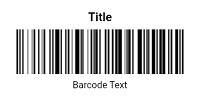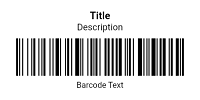Code 39, also known as Code 3 of 9, is a widely used barcode symbology that encodes alphanumeric data and a set of special characters. Its flexibility and ease of use have made it a popular choice for various applications in industries such as logistics, manufacturing, and healthcare.
Introduced in the 1970s, Code 39 was developed by the Intermec Corporation to provide a simple yet versatile barcode system capable of encoding letters, numbers, and a selection of symbols. Its design aimed to offer a balance between data capacity and readability, making it suitable for a range of applications.
Technical Specifications
Code 39 encodes up to 43 characters, including uppercase letters (A-Z), numeric digits (0-9), and a few special characters such as the dash (-), period (.), space, dollar sign ($), slash (/), and plus sign (+). Each character is represented by a sequence of bars and spaces, with patterns that allow scanners to distinguish between different characters.
The structure of a Code 39 barcode includes:
- Start and Stop Characters: Code 39 uses asterisks (*) as both the start and stop characters. This unique feature helps delineate the beginning and end of the data string.
- Data Characters: Each character in the data string is encoded using a combination of bars and spaces. The encoding pattern for each character consists of 5 bars and 4 spaces, arranged in a sequence that represents the character's unique pattern.
- No Checksum: Unlike some other barcode symbologies, Code 39 does not include a checksum. This simplifies the encoding process but places greater emphasis on ensuring data accuracy through careful scanning and printing.
Advantages and Disadvantages
Code 39 offers several advantages, including its ability to encode both letters and numbers, making it more versatile than numeric-only barcodes like UPC or MSI. Its use of standard ASCII characters allows for easy integration with various systems and applications. Additionally, Code 39 barcodes are relatively simple to generate and read, which contributes to their widespread adoption.
However, Code 39 also has limitations. Its lack of a built-in checksum can lead to higher error rates if the barcode is not printed or scanned accurately. The symbology's relatively large size compared to other barcodes, such as Code 128, may also be a drawback in applications where space is limited. Furthermore, the fixed-width bars and spaces can make the barcode less compact than more modern symbologies designed for higher data density.
Code 39 Applications
Code 39 is used in a variety of industries and applications due to its flexibility and ease of use:
- Logistics and Warehousing: Helps track and manage inventory items by encoding product codes, part numbers, or batch information.
- Healthcare: Used for patient identification, medication tracking, and medical device labeling, where alphanumeric data and ease of scanning are critical.
- Manufacturing: Applied for labeling and tracking components, tools, and equipment, ensuring accurate record-keeping and traceability.
- Retail: Provides a method for product identification and inventory management, particularly in settings where alphanumeric codes are necessary.
Comparison with Other Barcode Symbologies
Compared to other symbologies, Code 39 is notable for its ability to encode both letters and numbers, offering greater versatility than numeric-only barcodes like UPC. Unlike Code 128, which supports a broader range of characters and includes error detection mechanisms, Code 39 is simpler and does not include a checksum. Code 39's fixed-width character encoding results in larger barcodes, whereas Code 128 and other modern symbologies can offer more compact representations for similar data.
Code 39 is a versatile and widely used barcode symbology that provides a straightforward solution for encoding alphanumeric data. Its ease of implementation and ability to represent a range of characters make it suitable for various applications across logistics, healthcare, manufacturing, and retail. While it lacks some of the error-detection features of more complex symbologies and may be larger in size, its simplicity and adaptability have cemented its role as a reliable tool for data encoding and management.


